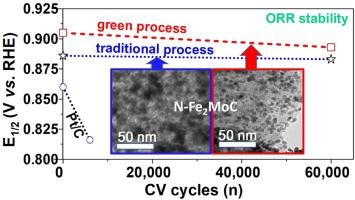Comparison of cost and performance between traditional and green processes for producing bimetallic carbide based oxygen reduction electrocatalysts
IF 8.1
2区 工程技术
Q1 CHEMISTRY, PHYSICAL
引用次数: 0
Abstract
Chemical (ion exchange resin) and biomass (water hyacinth leaves) as carbon precursors are adopted to prepare two kinds of bimetallic carbide (Fe2MoC)-based catalytic materials. It is found that, compared with the material that use ion-exchange resin as carbon precursor (N–Fe2MoC-RG), the material that use water hyacinth as carbon precursor (N–Fe2MoC-WHG) has more advantages in cost, environment protection, synthesis simplicity, and catalytic activity for oxygen reduction reaction (ORR). Therein, the N–Fe2MoC-WHG as a cathode catalyst displays a half-wave potential of 0.905 V (vs. RHE) for catalyzing ORR in alkaline media, and gets a high peak power density of 1.52 W cm−2 in alkaline electrolyte membrane fuel cell; moreover, the N–Fe2MoC-WHG displays higher power-density retention or growth rate at lower relative humidity, higher back pressure, higher working temperature and higher catalyst loading, compared with the N–Fe2MoC-RG. The N–Fe2MoC-WHG is one of the most active precious metal-free catalysts reported so far, and its stability is very excellent.

生产基于双金属碳化物的氧还原电催化剂的传统工艺与绿色工艺的成本和性能比较
采用化学(离子交换树脂)和生物质(布袋莲叶)作为碳前驱体,制备了两种基于双金属碳化物(Fe2MoC)的催化材料。研究发现,与以离子交换树脂为碳前驱体的材料(N-Fe2MoC-RG)相比,以水葫芦为碳前驱体的材料(N-Fe2MoC-WHG)在成本、环保、合成简便以及氧还原反应(ORR)催化活性等方面具有更多优势。其中,作为阴极催化剂的N-Fe2MoC-WHG在碱性介质中催化氧还原反应的半波电位为0.905 V(相对于RHE),在碱性电解质膜燃料电池中可获得1.52 W cm-2的高峰值功率密度;此外,与N-Fe2MoC-RG相比,N-Fe2MoC-WHG在较低相对湿度、较高背压、较高工作温度和较高催化剂负载条件下可获得更高的功率密度保持率或增长率。N-Fe2MoC-WHG 是迄今为止报道的最活跃的无贵金属催化剂之一,其稳定性也非常出色。
本文章由计算机程序翻译,如有差异,请以英文原文为准。
求助全文
约1分钟内获得全文
求助全文
来源期刊

International Journal of Hydrogen Energy
工程技术-环境科学
CiteScore
13.50
自引率
25.00%
发文量
3502
审稿时长
60 days
期刊介绍:
The objective of the International Journal of Hydrogen Energy is to facilitate the exchange of new ideas, technological advancements, and research findings in the field of Hydrogen Energy among scientists and engineers worldwide. This journal showcases original research, both analytical and experimental, covering various aspects of Hydrogen Energy. These include production, storage, transmission, utilization, enabling technologies, environmental impact, economic considerations, and global perspectives on hydrogen and its carriers such as NH3, CH4, alcohols, etc.
The utilization aspect encompasses various methods such as thermochemical (combustion), photochemical, electrochemical (fuel cells), and nuclear conversion of hydrogen, hydrogen isotopes, and hydrogen carriers into thermal, mechanical, and electrical energies. The applications of these energies can be found in transportation (including aerospace), industrial, commercial, and residential sectors.
 求助内容:
求助内容: 应助结果提醒方式:
应助结果提醒方式:


